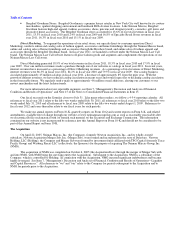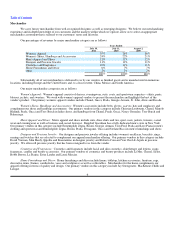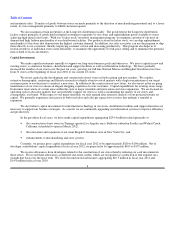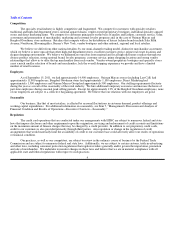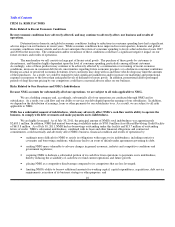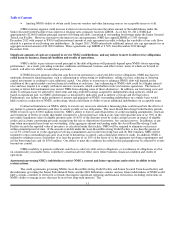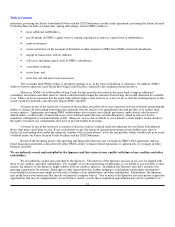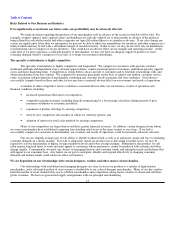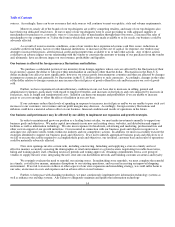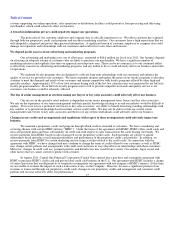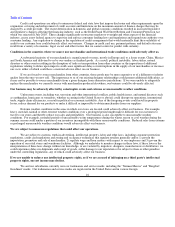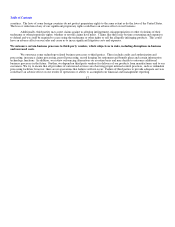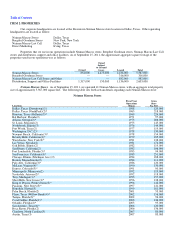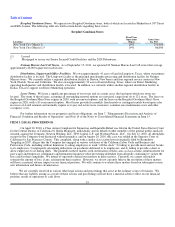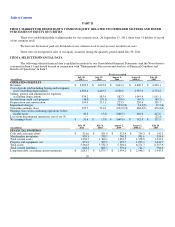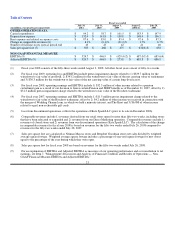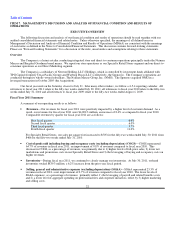Neiman Marcus 2010 Annual Report Download - page 16
Download and view the complete annual report
Please find page 16 of the 2010 Neiman Marcus annual report below. You can navigate through the pages in the report by either clicking on the pages listed below, or by using the keyword search tool below to find specific information within the annual report.
Table of Contents
Risks Related to Our Business and Industry
If we significantly overestimate our future sales, our profitability may be adversely affected.
We make decisions regarding the purchase of our merchandise well in advance of the season in which it will be sold. For
example, women's apparel, men's apparel, shoes and handbags are typically ordered six to nine months in advance of the products
being offered for sale while jewelry and other categories are typically ordered three to six months in advance. If our sales during any
season are significantly lower than we anticipated, we may not be able to adjust our expenditures for inventory and other expenses in a
timely fashion and may be left with a substantial amount of unsold inventory. If that occurs, we may be forced to rely on markdowns
or promotional sales to dispose of excess inventory. This could have an adverse effect on our margins and operating income. At the
same time, if we fail to purchase a sufficient quantity of merchandise, we may not have an adequate supply of products to meet
consumer demand, thereby causing us to lose sales or to harm our customer relationships.
The specialty retail industry is highly competitive.
The specialty retail industry is highly competitive and fragmented. We compete for customers with specialty retailers,
traditional and high-end department stores, national apparel chains, vendor-owned proprietary boutiques, individual specialty apparel
stores and direct marketing firms. Competition is strong both to attract and sell to customers and to establish relationships with, and
obtain merchandise from, key vendors. We compete for customers principally on the basis of quality and fashion, customer service,
value, assortment and presentation of merchandise, marketing and customer loyalty programs and store ambiance. Our failure to
successfully compete based on these and other factors may have a material adverse effect on our revenues and results of operations.
A number of other competitive factors could have a material adverse effect on our business, results of operations and
financial condition, including:
• increased operational efficiencies of competitors;
• competitive pricing strategies, including deep discount pricing by a broad range of retailers during periods of poor
consumer confidence or economic instability;
• expansion of product offerings by existing competitors;
• entry by new competitors into markets in which we currently operate; and
• adoption of innovative retail sales methods by existing competitors.
Many of our competitors are larger than us and have greater financial resources. In addition, certain designers from whom
we source merchandise have established competing free-standing retail stores in the same vicinity as our stores. If we fail to
successfully compete for customers or merchandise, our revenues and results of operations could be materially adversely affected.
Our success depends in large part on our ability to identify fashion trends as well as to anticipate, gauge and react to changing
consumer demands in a timely manner. If we fail to adequately match our product mix to prevailing customer tastes, we may be
required to sell our merchandise at higher average markdown levels and lower average margins. Furthermore, the products we sell
often require long lead times to order and must appeal to consumers whose preferences cannot be predicted with certainty and often
change rapidly. Consequently, we must stay abreast of emerging lifestyle and consumer trends and anticipate trends and fashions that
will appeal to our consumer base. Any failure on our part to anticipate, identify and respond effectively to changing consumer
demands and fashion trends could adversely affect our business.
We are dependent on our relationships with certain designers, vendors and other sources of merchandise.
Our relationships with established and emerging designers are a key factor in our position as a retailer of high-fashion
merchandise, and a substantial portion of our revenues is attributable to our sales of designer merchandise. Many of our key vendors
limit the number of retail channels they use to sell their merchandise and competition among luxury retailers to obtain and sell these
goods is intense. We have no guaranteed supply arrangements with our principal merchandising
13


